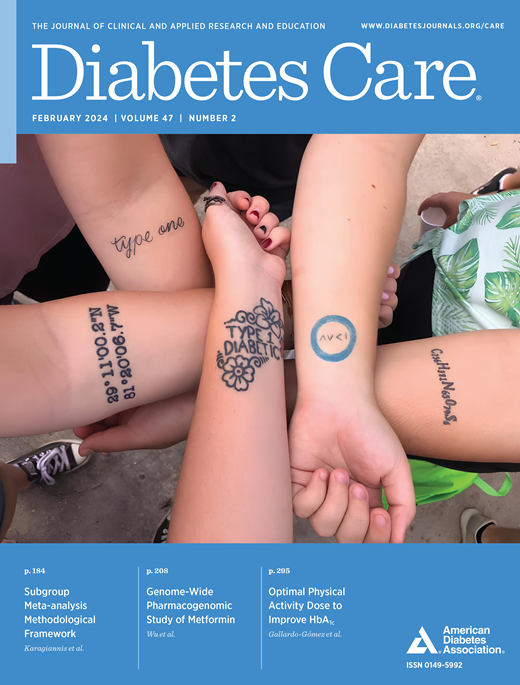高级混合闭环疗法对高 HbA1c 青少年的血糖和心理社会疗效:随机临床试验
IF 14.8
1区 医学
Q1 ENDOCRINOLOGY & METABOLISM
引用次数: 0
摘要
目的 确定高级混合闭环疗法(AHCL)对血糖不达标的连续皮下胰岛素输注(CSII)±连续血糖监测(CGM)高危青少年群体的疗效。研究设计与方法 在一项为期 6 个月的多中心临床试验中,患有 1 型糖尿病、平均 HbA1c &;gt;8.5%(65 mmol/mol)的青少年按 1:1 随机分配接受 AHCL 或常规治疗(CSII ± CGM)。主要结果是 24 周的组间 HbA1c 差异。次要结果包括来自蒙面 CGM 的 CGM 指标和使用有效问卷评估的心理测量指标(青少年报告的糖尿病问题领域 [PAID]、生活质量、焦虑、抑郁和低血糖恐惧)。结果 共有 42 名参与者(平均 [SD] 年龄为 16.2 [2.5] 岁,HbA1c 为 9.8 [1.1] % 或 84 [12] mmol/mol,PAID 得分为 50.3 [19.8])被随机选中。研究结束时,AHCL 的平均(标清)HbA1c 为 8.8 (1.1)% 或 73 (12) mmol/mol,CSII ± CGM 的平均(标清)HbA1c 为 9.9 (1.2)% 或 85 (13.1) mmol/mol,调整后的平均组间差异为 -0.77% (95% CI -1.45 to -0.09) 或 -8.4 mmol/mol (-15.8 to -1.0); P = 0.027。AHCL 增加了在 70-180 mg/dL 范围内的时间(差异为 19.1%;95% CI 为 11.1 至 27.1),减少了在 >180 mg/dL 范围内的时间(差异为 -17.7%;95% CI 为 -26.6 至 -8.8),而在 <70 mg/dL 范围内的时间没有增加(差异为 -0.8%;95% CI 为 -2.7 至 0.6)。研究结束时,没有证据表明两组患者的社会心理结果存在差异。结论 对于血糖不达标的青少年,应鼓励其进行糖化血红蛋白治疗,因为糖化血红蛋白治疗可改善血糖。然而,心理支持仍然至关重要,因为仅靠技术可能无法减轻这一亚群的糖尿病护理负担。本文章由计算机程序翻译,如有差异,请以英文原文为准。
Glycemic and Psychosocial Outcomes of Advanced Hybrid Closed Loop Therapy in Youth With High HbA1c: A Randomized Clinical Trial
OBJECTIVE To determine the efficacy of advanced hybrid closed loop (AHCL) therapy in a high-risk cohort of youth on continuous subcutaneous insulin infusion (CSII) ± continuous glucose monitoring (CGM) with suboptimal glycemia. RESEARCH DESIGN AND METHODS In a 6-month multicenter clinical trial, youth with type 1 diabetes with mean and most recent HbA1c > 8.5% (65 mmol/mol) were randomly assigned 1:1 to AHCL or treatment as usual (CSII ± CGM). The primary outcome was the 24-week between-group difference in HbA1c. Secondary outcomes included CGM metrics from masked CGM and psychological measures (youth-reported problem areas in diabetes [PAID], quality of life, anxiety, depression, and hypoglycemia fear) assessed using validated questionnaires. RESULTS A total of 42 participants were randomized (mean [SD] age 16.2 [2.5] years, HbA1c 9.8 [1.1]% or 84 [12] mmol/mol, PAID score 50.3 [19.8]). At study end, the mean (SD) HbA1c was 8.8 (1.1)% or 73 (12) mmol/mol with AHCL and 9.9 (1.2)% or 85 (13.1) mmol/mol with CSII ± CGM, with mean adjusted group difference of −0.77% (95% CI −1.45 to −0.09) or −8.4 mmol/mol (−15.8 to −1.0); P = 0.027. AHCL increased time in range 70–180 mg/dL (difference 19.1%; 95% CI 11.1 to 27.1), reduced time >180 mg/dL (difference −17.7%; 95% CI −26.6 to −8.8), with no increase in time spent <70 mg/dL (difference −0.8%; 95% CI −2.7 to 0.6). There was no evidence for difference in psychosocial outcomes between the two groups at study end. CONCLUSIONS AHCL should be encouraged in youth with suboptimal glycemia, as AHCL improves glycemia. However, psychological support remains vital, as technology alone may not be able to reduce the burden of diabetes care in this subgroup.
求助全文
通过发布文献求助,成功后即可免费获取论文全文。
去求助
来源期刊

Diabetes Care
医学-内分泌学与代谢
CiteScore
27.80
自引率
4.90%
发文量
449
审稿时长
1 months
期刊介绍:
The journal's overarching mission can be captured by the simple word "Care," reflecting its commitment to enhancing patient well-being. Diabetes Care aims to support better patient care by addressing the comprehensive needs of healthcare professionals dedicated to managing diabetes.
Diabetes Care serves as a valuable resource for healthcare practitioners, aiming to advance knowledge, foster research, and improve diabetes management. The journal publishes original research across various categories, including Clinical Care, Education, Nutrition, Psychosocial Research, Epidemiology, Health Services Research, Emerging Treatments and Technologies, Pathophysiology, Complications, and Cardiovascular and Metabolic Risk. Additionally, Diabetes Care features ADA statements, consensus reports, review articles, letters to the editor, and health/medical news, appealing to a diverse audience of physicians, researchers, psychologists, educators, and other healthcare professionals.
 求助内容:
求助内容: 应助结果提醒方式:
应助结果提醒方式:


